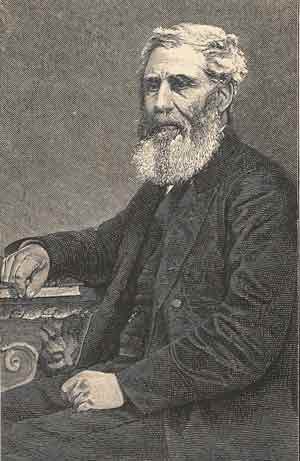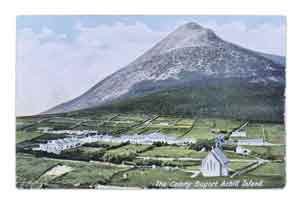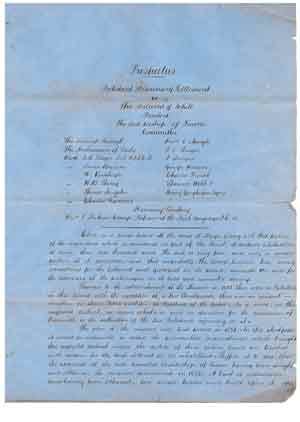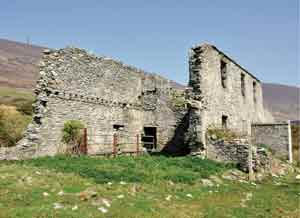EVANGELICAL MISSION PIVOTS TO LANDLORD IN FAMINE ACHILL
Published in Features, Issue 4 (July/August 2022), Volume 30By Patricia Byrne

Above: Revd Edward Nangle, who founded the Achill Mission colony in the early 1830s. (Glucksman Library, UL)
On 1 April 1851 Edward Nangle, who had founded the Achill Mission colony in the early 1830s, publicly announced that the Mission had purchased the major part of the island from the Encumbered Estates Commissioner for £17,500. This put the Mission on a new trajectory as the major Achill landlord. The University of Limerick library has acquired a rare nineteenth-century handwritten document, ‘Prospectus. Protestant Missionary Settlement in the Island of Achill’, dated 1848 and designed to raise funds for this land purchase. The seven-page document—in all likelihood penned by Edward Nangle—provides a unique firsthand account of the colony’s development over the 1834–48 period. It covers the sectarian unrest in the colony’s first decade, the Mission activities in the Great Famine years, and the Mission’s stated motivation for seeking to acquire substantial additional Achill land from the estate of Sir Richard O’Donnell.
The dating of the document as 1848, three years before the land was actually purchased, is significant. This was the year in which another failure of the potato crop deepened the famine crisis across the country, and Edward Nangle was embroiled in continued controversy over the linking of famine relief to proselytism, particularly through the Achill school food programme. The prospectus document reveals—and this is confirmed in the Mission’s annual report for 1848—that throughout the famine years of 1845–8 extensive development work was under way on a satellite Achill Mission colony at Mweelin (Meelan) in west Achill, following the earlier acquisition of a tract of land from Sir Richard O’Donnell. The continued physical expansion of the colony was therefore an established feature of Edward Nangle’s strategy before the onset of the Great Famine.
SECTARIAN SKIRMISHES
The early sections of the prospectus are devoted to an account of the Mission’s development over the first decade or so of its operations, a period characterised by sectarian skirmishes, heightened tensions during provocative visits by Archbishop John MacHale to the island, and the Mission’s work around education and the conversion of ‘persons from the ranks of popery from among the natives of Achill’. The reference to violent incidents and ‘one warm friend of the Mission [who] was murdered’ concerns Captain Reynolds, the coastguard officer and friend of the Mission who died as a result of injuries received in a fracas in December 1837. This was the year in which Edward Nangle founded the Achill Missionary Herald, a publication which he edited for almost four decades and which he used as a highly effective tool in promoting the Achill Mission and raising funds for its development. The Herald was printed in Achill at the Dugort printing office, where the production work was carried out ‘by the boys of the Settlement under the superintendence of a qualified foreman’. As in the prospectus document, a recurring theme in the early Herald issues was the continual resistance, aggression and violence which, Edward Nangle claimed, the colony endured from its opponents. Such accounts undoubtedly helped the effort of attracting financial support from the Mission’s friends and supporters across Ireland and England.
IMPRESSIVE DEVELOPMENT ON SLIEVEMORE’S SLOPES
The prospectus outlines the main components of the colony’s development, in which education played a central role. In the early years, four colony schools were opened ‘into which the poor children pressed so eagerly that the number of scholars soon exceeded four hundred’, leading to fierce retaliation by Archbishop John MacHale and his priests, who set up competing schools. In 1831 the chief secretary of Ireland had set out the bones of a new non-denominational State-supported system of elementary education for Ireland in what became known as the ‘Stanley Letter’. Both Edward Nangle and John MacHale fiercely opposed the scheme, each arguing that secular and religious education were inseparable. The pragmatic archbishop, however, faced with the growth of the Achill Mission schools, availed of the opportunity to use the State funding available to establish schools, which were essentially under the influence of his local Catholic clergy.
The prospectus describes the other elements of the colony: an ‘Orphan Refuge for educating the children of Roman Catholic parents in the Protestant faith’—essentially another conversion tool. The colony also included an asylum for Catholic priests who converted to the Protestant faith. This asylum was established at Dugort on the eve of the Great Famine in a public and provocative ceremony at around the same time as a system of public recantations by converts was also initiated. A less controversial feature of the colony was its hospital and dispensary, run by Dr Neason Adams, who appears to have escaped any charge of linking his medical services to religious affiliation.
The prospectus also references the colony hotel, ‘built and furnished for the accommodation of visitors’. Edward Nangle referred frequently to the attractions of Achill for tourists, no doubt aware that this aspect would appeal to the audience whom he was targeting for funds. The opening paragraph of the document describes the many attractions that Achill holds for the botanist and geologist and ‘for the admirers of the picturesque in its bold and romantic scenery’. In later years, Nangle wrote a tourist guide to the island at a time when rail access was opening up the west of Ireland for visitors.

Above: A colourised postcard of the Dugort colony, Achill Island, in the mid-nineteenth century. (Glucksman Library, UL)
‘THE FAMINE WITH WHICH GOD HAS AFFLICTED THIS LAND’
The prospectus was compiled in 1848 as the Great Famine raged, and it opens its famine account with reference to a recurring theme in Edward Nangle’s writings and sermons of the period, i.e. that the disaster resulted from God’s anger at a sinful people: ‘the Famine with which God has afflicted this land’. Secondly, the writer is of the view that the Famine had opened up a significant opportunity for the Achill Mission to achieve ‘an entire eradication of Popery from this district’. The basis for this assertion was that Catholics had been neglected by their pastors in their time of need while Protestant friends of the Mission were generous in their support to relieve distress. Famine, the prospectus states, had turned ‘the tide of popular feeling against Romanism and in favour of Scriptural Christianity’. The opportunity presented was nothing less than ‘the Protestantizing’ of all the inhabitants of the island.
Once again, education was central to the Mission’s famine response: ‘The native children have almost all been gathered into Irish Schools, in which they are receiving a thoroughly Protestant education’, and ‘every village throughout this extensive parish has now its Irish school’. What the prospectus doesn’t mention, perhaps owing to sensitivities around then current charges that Edward Nangle was ‘a buyer of souls’, was the colony school food programme. At the start of the Famine, the Achill Mission had decided to feed the children in its own and neighbouring schools, leading to a surge in demand for places in the schools, which included a programme of scriptural education. By 1848, at the time the prospectus was being put together, over 1,000 children were being fed in the Achill Mission schools. As a result of the success of its schools’ programme, the prospectus confidently asserts that ‘a very great wasting if not an entire eradication of Popery from this district will result from this extensive diffusion of the principals of true religion among its population’.

Above: Opening page of ‘Prospectus. Protestant Missionary Settlement in the Island of Achill’. (Glucksman Library, UL)
‘PROTESTANTIZING OF THE ENTIRE INHABITANTS OF THE ISLAND’
The prospectus views the opportunity presented to the Achill Mission as resulting not only from the change in popular opinion during the Famine but also from the sale of indebted estates via the Encumbered Estates Court and the willingness of Sir Richard O’Donnell, proprietor of a large tract of Achill lands, to sell to the Achill Mission committee ‘at its pain[sic? or plain?] value’. Such a purchase is presented as having several advantages: first, ensuring the continuance of the existing Achill Mission; second, leading to the potential ‘Protestantizing of the entire inhabitants of the island’; third, offering a place of refuge to converts from outside Achill. While much of the land to be acquired is presented as being of poor quality, it is argued that it was capable of being greatly improved along the lines of the reclamation work already carried out on the existing colony property.
The prospectus goes on to throw up an even greater and bold opportunity if the land purchase is achieved: the income from the property could be used for the maintenance of the existing Achill Mission establishment, but in future years any surplus arising could be used to establish and maintain other missionary settlements in the battle against popery. Four people had agreed to act as trustees to manage the purchase funds and to deal with Sir Richard O’Donnell in relation to the transaction. One of the trustees was Somerset Maxwell, whose father, Lord Farnham, was a landlord who had promoted scriptural education on his Cavan estate in the 1820s when the young Edward Nangle was a curate in nearby Arva. Two of the trustees would later, in the 1860s, be at the centre of an acrimonious internal debate about the direction of the Achill Mission.
VISION UNREALISED
It is interesting to explore the outcome of the land purchase by the Achill Mission as against the promise held out in the prospectus document. When, three years after the prospectus was written, the Achill Mission trustees formally entered into an agreement with Sir Richard O’Donnell for the purchase of his Achill estate, Edward Nangle provided a further reason for this transaction, namely the threat posed by John MacHale’s acquisition of an extensive site at Bunnacurry, Achill, where a Franciscan monastery would be established as part of an energetic fight-back against the Achill Mission. By the time the transaction was complete, Edward Nangle had left Achill to take up a post at Skreen, Co. Sligo, while remaining the public figurehead of the Mission.
In a radical departure from its previous approach, the Achill Mission decided in 1852 to delegate its missionary work to Alexander Dallas, who had set up the Society for Irish Church Missions (ICM) during the Famine to bring scriptural Protestantism to the people of Connemara. It eventually became the largest evangelical mission aiming to convert the Catholics of Ireland. The arrangement with Dallas and the Irish Church Mission lasted for just four years. By then, the Achill Mission was facing a decline in its main fund-raising activities abroad and was under pressure to pay for its own missionary work out of its estate income.
A number of years later, a serious internal conflict surfaced when a number of Achill Mission trustees questioned the allocation of resources as between the improvement of conditions for its tenants versus its own internal estate and evangelisation work. The dissenting trustees considered it their duty to ensure that the money subscribed for the purchase of the Achill estate brought about an improvement in the living conditions of the colony tenants. It was several years before the conflict between the Achill Mission trustees and management committee was finally resolved after long and expensive litigation. The dispute drained the Mission of energy and resources. The organisation went into decline, negatively affected by internal strains, income decline, emigration of converts and sectarian tensions. The vision set out in its 1848 prospectus was thus not realised.
CONCLUSION
This document is a valuable primary source in providing insight, from an Achill Mission perspective, into its evangelical mission from the early 1830s through to the Famine year of 1848. We learn of its evangelical intent, its methods, the resulting conflicts and its response to the Famine crisis.
The Prospectus provides a vivid picture of nineteenth-century evangelicalism played out in a remote western location and based on a conviction that the ills of Ireland and its people resulted from an adherence to Roman Catholicism. It positions education at the centre of the Achill Mission’s work and the main source of conflict between Edward Nangle and Archbishop John MacHale, with the island schools becoming their battleground. While failing to mention the practice of feeding children in its scriptural schools during the Famine, the prospectus reveals that the Mission viewed the growth of attendance at its schools in that period as providing a unique opportunity and momentum to finally break the stranglehold of Catholicism in Achill.
The momentum of Achill conversions was not maintained when the Famine ended. The intertwining of landlord and missionary roles within the Achill Mission led to internal and external tensions and was one of the factors leading to the decline of the colony as an institution throughout the second half of the nineteenth century.
Patricia Byrne is the author of The preacher and the prelate—the Achill Mission colony and the battle for souls in Famine Ireland (Merrion Press, 2018).
Further reading
N. Branach, ‘Edward Nangle and the Achill Island Mission’, History Ireland 8 (3) (2000).
M. Ní Ghiobúin, Dugort, Achill Island, 1831–1861: the rise and fall of a missionary community (Dublin, 2001).
I. Whelan, The Bible War in Ireland (Dublin, 2005).

















